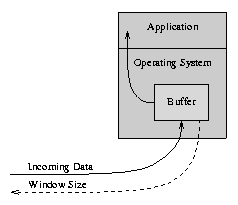
A sliding window algorithm places a buffer between the application program and the network data flow. For TCP, the buffer is typically in the operating system kernel, but this is more of an implementation detail than a hard-and-fast requirement.

Data received from the network is stored in the buffer, from whence the application can read at its own pace. As the application reads data, buffer space is freed up to accept more input from the network. The window is the amount of data that can be "read ahead" - the size of the buffer, less the amount of valid data stored in it. Window announcements are used to inform the remote host of the current window size.
If the local application can't process data fast enough, the window size will drop to zero and the remote host will stop sending data. After the local application has processed some of the queued data, the window size rises, and the remote host starts transmitting again.
On the other hand, if the local application can process data at the rate it's being transferred, sliding window still gives us an advantage. If the window size is larger than the packet size, then multiple packets can be outstanding in the network, since the sender knows that buffer space is available on the receiver to hold all of them. Ideally, a steady-state condition can be reached where a series of packets (in the forward direction) and window announcements (in the reverse direction) are constantly in transit. As each new window announcement is received by the sender, more data packets are transmitted. As the application reads data from the buffer (remember, we're assuming the application can keep up with the network), more window announcements are generated. Keeping a series of data packets in transit ensures the efficient use of network resources.